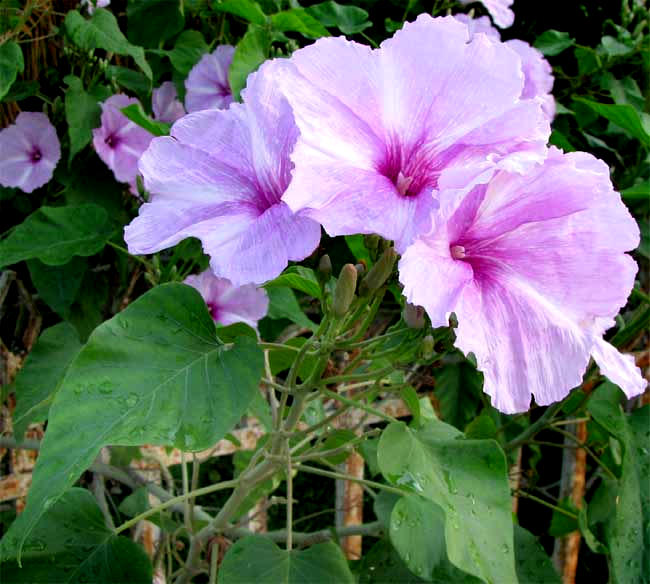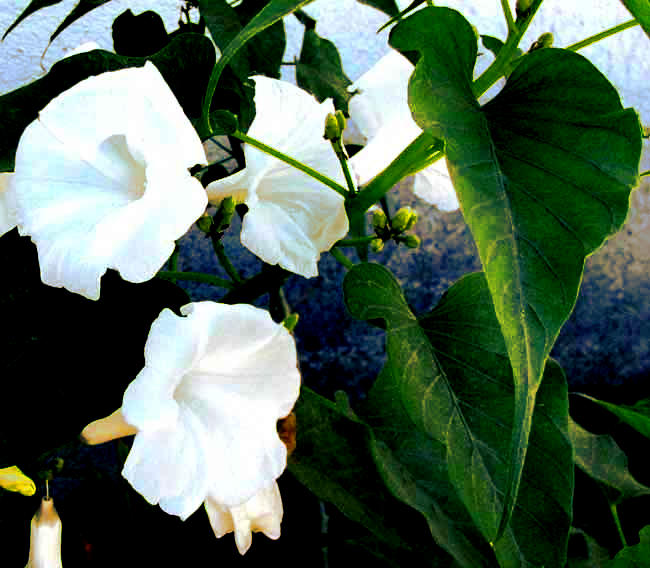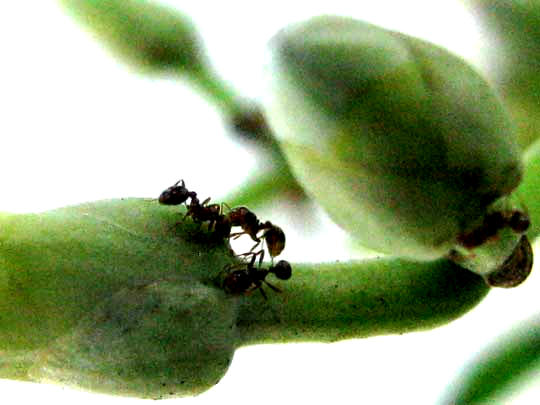Excerpts from Jim Conrad's
Naturalist Newsletter

from the August 11, 2008 Newsletter issued from Yucatán, MÉXICO
MORNING GLORY TREES ABLOOM IN MÉRIDA
Sunday morning I walked along Mérida's famous Paseo de Montejo, a spacious, divided-lane, parklike avenue incorporating several traffic circles with monuments in their centers, and bordered with wide sidewalks with many pleasant places in which to sit. Special efforts are made to cultivate pretty plants along the avenue. A large variety of palms can be seen, bright bougainvilleas run along stone walls and art displays are set up here and there.
The most eye-catching flowering plants nowadays are the bougainvilleas, oleanders of various flower colors, and Royal Poincianas, all of which I've already introduced in these newsletters. One plant gorgeously flowering which I've not talked about, however, is an eight-ft-tall shrub branching from the base, bearing heart-shaped leaves on long petioles, and abundant cup-size, funnel-shaped, pink flowers is the Morning-Glory Tree, IPOMOEA CARNEA. The genus Ipomoea is truly the Morning-Glory genus, so this plant is a morning-glory in every respect, except that it's a woody bush, while of course morning-glories are "supposed" to be herbaceous vines, at least in the minds of temperate-zone plant lovers. That's it above.
Tree Morning-Glories are native to tropical America. In our area, because of their beauty, ease of propagation and general toughness they deserve to be planted much more than they are. However, beyond tropical America the species is becoming an invasive, threatening native plants. It's prohibited in Florida and Arizona. Despite it growing here in an arid zone, in Paraguay it's regarded as an aggressive weed in wetlands and I read on the Internet that it's "found all over India."
Medicinally, its roots are boiled to use as laxative and to provoke menstruation, and the milky sap is used by traditional healers for skin diseases. However, it's dangerous when used wrong, for it's a depressant on the central nervous system, and a relaxant for muscles. It's regarded as poisonous for cattle.
from the January 23, 2011 Newsletter issued from Hacienda Chichen Resort beside Chichén Itzá Ruins, central Yucatán, MÉXICO; limestone bedrock, elevation ~39m (~128ft), ~N20.676°, ~W88.569°
ANTS ON A MORNING-GLORY TREE
On my last trip to Pisté, happily blossoming on the shady north side of a white-stuccoed house, was a white-flowered form of the Morning-Glory Tree we've already seen, which was pink-flowered. The white one is shown below:

Also, the calyxes of the Pisté plant were well populated with ants busy supping nectar, as shown below:

Last week we saw such "extrafloral nectaries" at the sepal bases of a Ginger-leaf Morning-Glory, so such glands appear to be fairly common among morning-glories. Tree Morning-Glories also bear such glands on their leaf petioles.
The nectar secreted by these glands is a rich mixture of sugars and amino acids. With this nectar the plant attracts ants that will attack herbivores who come along wanting to eat the plant. When I tapped with my finger near the ants in the picture one rushed onto my finger to bite it, and would have managed if I hadn't nudged him back onto his flower.